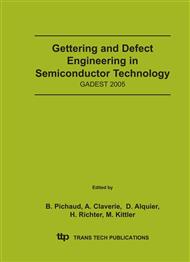[1]
Y. Naitoh, K. Tsukagoshi, K. Murata, and W. Mizutani, Surf. Sci. Nanotech., 2003, 1, 41-44.
Google Scholar
[2]
D. Strachan, et al.; Appl. Phys. Lett., 2005, 86, 043109.
Google Scholar
[3]
A. Sibbald (1983) Proc. Inst. Elec. Eng. I, 130, 233-244.
Google Scholar
[4]
P. Bergveld, J. Wiersma and H. Meertens: IEEE Trans Biomed. Eng. 23 (1976) pp.136-144.
Google Scholar
[5]
P. Fromherz, A. Offenhäusser, T. Vetter and J. Weis: Science 252 (1991) pp.1290-1293.
Google Scholar
[6]
A. Offenhäusser, C. Sprössler, M. Matsuzawa and W. Knoll: Biosens Bioelectron 12 (1997) pp.819-826.
Google Scholar
[7]
L. Bousse, J. Shott and J. D. Meindl: IEEE Electron Device Letters 9 (1988) pp.44-46.
Google Scholar
[8]
A. Offenhäusser, J. Rühe, and W. Knoll: J. Vac. Sci. Techn., A: 13 (1995) pp.2606-2612.
Google Scholar
[9]
A. Cohen, M. E. Spira, S. Yitshaik, G. Borghs, O. Shwartzglass and J. Shappir: Biosensors and Bioelectronics 19 (2004) pp.1703-1709.
DOI: 10.1016/j.bios.2004.01.021
Google Scholar
[10]
S. Meyburg, M. Goryll, J. Moers, S. Ingebrandt, S. Böcker-Meffert, H. Lüth and A. Offenhäusser: Biosensors and Bioelectronics in press.
DOI: 10.1016/j.bios.2005.03.010
Google Scholar
[11]
W. G. Regehr, J. Pine, C.S. Cohan, M.D. Mischke and D.W. Tank. J. Neurosci. Meth. 30 (1989) pp.91-106.
Google Scholar
[12]
R. Weis and P. Fromherz: Phys. Rev. E 55 (1997) pp.877-889.
Google Scholar
[13]
S. Vassanelli and P. Fromherz:. Appl. Phys. A 66(1998) pp.459-463.
Google Scholar
[14]
J. Rühe, R. Yano, J.S. Lee, P. Köberle, W. Knoll and A. Offenhausser: J. Biomat. Sci. - Polymer Ed. 10 (1999) pp.859-874.
Google Scholar
[15]
M. Scholl, C. Sprössler, M. Denyer, M. Krause, K. Nakajima, A. Maelicke, W. Knoll and A. Offenhäusser: J. Neurosci. Meth. 104 (2000) pp.65-75.
DOI: 10.1016/s0165-0270(00)00325-3
Google Scholar
[16]
M.C.T. Denyer, M. Riehle, J. Hayashi, M. Scholl, C. Sprössler, S.T. Britland, A. Offenhäusser and W. Knoll:. Bioassay development: In Vitro Cellular & Developmental Biology-Animal 35 (1999) pp.352-356.
DOI: 10.1007/s11626-999-0086-5
Google Scholar
[17]
C. Sprössler, M.C.T. Denyer, S. Britland, W. Knoll and A. Offenhäusser: Phys. Rev. E 60 (1999) pp.2171-2176.
DOI: 10.1103/physreve.60.2171
Google Scholar
[18]
S. Ingebrandt, C.K. Yeung, M. Krause and A. Offenhäusser: Biosensors & Bioelectronics 16 (2001) 565-570.
DOI: 10.1016/s0956-5663(01)00170-1
Google Scholar


